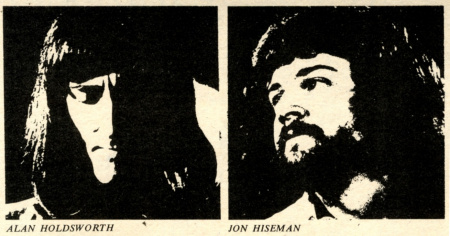The Silent Man In Tempest (disc 1973)
Summary: In 1973, the enigmatic guitarist Alan Holdsworth, hailing from Yorkshire, emerged in London's music scene, captivating audiences and fellow musicians alike. After impressing at Ronnie Scott's Guitar Festival, Holdsworth joined Jon Hiseman's Tempest, a band marked by comparisons to Cream. Despite his quiet persona, Holdsworth's extraordinary talent made him a sought-after musician in the evolving music landscape of the time. [This summary was written by ChatGPT in 2023 based on the article text below.]
The silent man in Tempest

Disc-January 13, 1973
Andrew Tyler
Alan Holdsworth comes from Keighley in Yorkshire, and after leaving school worked as an apprentice basket-maker for three years. Much of what took place before, during and after those historic milestones is a mystery to virtually all his newfound London friends, and that includes Jon Hiseman, whose new group, Tempest, Holdsworth has recently joined.
Holdsworth is a marvellously mysterious and talented guitar picker who seems to have been "discovered" by, among others, saxist Ray Warleigh. He was doing his semi-pro bit at the time . . . working for a few quid at a Sunderland Mecca ballroom. Warleigh like just about everyone who's seen him since, was considerably moved and encouraged him to come to London.
Soon afterwards Holdsworth played a set at Ronnie Scott's and as a result, received an invitation to take part in the club's September 1972 Guitar Festival.
Still unknown in the public eye, he was to represent "the music of today" and play alongside the formidable acoustic player John Williams, and jazz guitarist Barney Kessel. Kessel, we are told, was impressed by Holdsworth's lightning fingers and baffled by the rich and varied tones he could coax from his instrument.
"What sort of strings are you using," he wondered. "and is that a regular neck and how do you get that strange growling sound and how come, etc, etc . . ."
Holdsworth, by now was a hunted man. Word of his talent reached several ears and various band leaders crouched cat-fashion, ready to stuff pound notes into his pockets and seduce his senses with enticing and lurid offers. Jon Hiseman leapt in first. "I got word that he was in London and he came round to my place. After he'd played for ten minutes I knew he was right."
Holdsworth, by all accounts, is a quiet, almost silent character who offers little of himself outside a musical context. He'll slip away up north for days at a time and just as suddenly reappear in time for a rehearsal.
Hiseman is well known to anyone intimate with the heroic circle of musicians encompassing people like Graham Bond, Georgie Fame, John Mayall and Hexstall-Smith and so on. They represent a wildly divergent corner of contemporary British sounds but are more often than not bracketed as "jazz/ rockers" - a tag with which Hiseman is uncomfortable. He was drummer and founding father of the many-headed Colosseum - born in the autumn of 1968 and put to rest October '71. The death knell was finally sounded by guitarist Dave "Clem" Clempson who left the band for Humble Pie.
Hiseman was already shaping plans for a more compact unit. Colosseum, for all its talent and energy, had finally become unmanageable. The attendant entourage of roadies and business types had swollen beyond a sensible level and the music was becoming correspondingly awkward.
"I began thinking of forming a four-piece," said Jon, "and if Dave hadn't joined Pie he would have been a natural choice for lead guitar. The problem was finding someone who was pretty ridiculous but not too well known because, to be realistic, I couldn't see a biggie from a top-flight band dropping everything to join us. It was an almost insoluble problem and then I began hearing rumours about this lunatic guitarist who was just unbelievable."
The line-up is completed by two of Hiseman's old friends - Mark Clarke and Paul Williams. Clarke, on bass. keyboards and vocals, was with Colosseum during their last year and after the split joined Uriah Heep in November '71. Paul Williams primarily lead vocals, some percussion, guitar and keyboards, first sang with Jon when the pair were together in the Wes Minster Five. Before that there were gigs with Georgie Fame at the Flamingo and with Alexis Korner at the Marquee, and in 1963 he joined Zoot Money's Big Roll Band for four-and-a-half years. In 1967 came a one-year stopover with John Mayall, followed by gigs with the Alan Price Set, Poet And One Man Band, Ainsley Dunbar and, finally, Juicy Lucy.
Williams' career often ran a close parallel with Hiseman's. Jon began with the Graham Bond Organisation - filling the gap left by Ginger Baker's departure for Cream. From there came a spell with Georgie Fame. The New Jazz Orchestra (which he helped form in 1962 and which is still alive) followed by a rewarding association with Mayall. After Mayall performed one of his customary juggling acts in 1968, Jon set about forming Colosseum.
Hiseman's new line-up have already cut a debut album and on January 12 begin a series of European dates. By March they plan to hit the English university circuit. Tempest will probably be compared to early Cream, since the line-up and emphasis are often similar, yet Hiseman, as always, is reluctant to categorise his work.
"We're a new band that plays the music of today and not yesterday," he says, "But if people want to compare us with Cream that suits me down to the ground."

